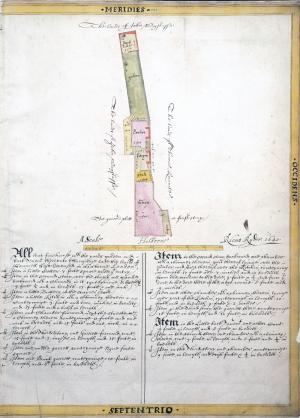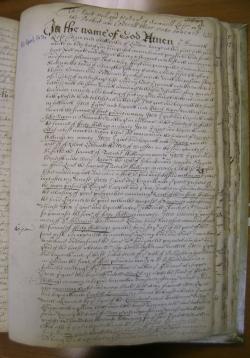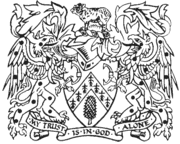 Samuel Lese bequeathed two tenements at Holborn Bridge to the Company. In his will, dated 26 April 1634, Lese outlined his intentions for his property at Holborn and another tenement at Mutton Lane.[1] In the first instance, he instructed that his servant, Isabel Harrison, be allowed to remain in his house at Holborn Bridge for a period of ten years following his death. The grant to Isabel included the house, garden and small plot of land. She was also to receive all of his goods and chattels in the house at Holborn and further properties in Field Lane and Lese’s shop in Shoe Lane.[2] After the term of ten years, the property was to revert to The Clothworkers’ Company, along with the house next to it, and a tenement with a plot of land in Mutton Lane. One appears to have been his place of residence, and he requested that he buried in the parish church of St. Andrew Holborn in his will.
Samuel Lese bequeathed two tenements at Holborn Bridge to the Company. In his will, dated 26 April 1634, Lese outlined his intentions for his property at Holborn and another tenement at Mutton Lane.[1] In the first instance, he instructed that his servant, Isabel Harrison, be allowed to remain in his house at Holborn Bridge for a period of ten years following his death. The grant to Isabel included the house, garden and small plot of land. She was also to receive all of his goods and chattels in the house at Holborn and further properties in Field Lane and Lese’s shop in Shoe Lane.[2] After the term of ten years, the property was to revert to The Clothworkers’ Company, along with the house next to it, and a tenement with a plot of land in Mutton Lane. One appears to have been his place of residence, and he requested that he buried in the parish church of St. Andrew Holborn in his will.
In a codicil, dated 30 April 1634, Lese set down further conditions governing the rents from his properties at Holborn Bridge and Mutton Lane.[3] He requested that the Company give money towards several charities. These included the establishment of a loan scheme to honest young men of the Company upon security for a period of time to be devised by the Master and Wardens; the distribution of profits from this money to the poor, aged men and women of the Company; and a sermon to be preached annually on a festival day.[4] He also bequeathed 5s. to the anyone appointed as his executor for the pains taken in their fulfilment of these conditions. These charitable outlays added to those set down in his original will, when he granted forty shillings to the prisons at Ludgate, Newgate and the two Compters, and paid forty shillings to the St. Paul’s Cathedral and the parish of St. Andrew, Holborn.[5]
The Company managed the Lese properties at Holborn following his death. In line with the the intentions in his will, the early management related only to one tenement. The first record of the property in the Company Court Orders relates to a suit for a lease of the property in December 1634 by William Cox, Haberdasher, the occupier of the property.[6] On foot of his request, the Company issued orders for a survey of the property to be taken by Company officers, including Mr. Trussell, Mr. Carpenter, Mr. Hodges, Mr. Burnell, Mr. Ferrers and Mr. Alexander.[7] The Company granted Cox a new lease in January 1635.[8] The lease was for twenty-one years, and would commence on 25 March 1635. It required payment of both an annual rent of £15 and a fine of £50.[9] The only condition attached was that Cox should surrender his old lease, which would then be cancelled.[10]
William Cox made suit to the Company for a lease of the two tenements at Holborn Bridge.[11] This suggests that Lese’s servant, Isabel Harrison, may have died in the ensuing three years. The Company took the opportunity to survey the properties, with Mr. Boylston, Mr. Wilson, Mr. Webb, Mr. Jackson, and Mr. Thriscrosse all appointed as viewers.[12] No new lease appears to have been issued again. In October 1640, Cox made a further suit for a lease, which prompted the Company to undertake another survey.[13] Once again, no records survive to suggest that the lease was ever issued. In August 1644, Cox, who was described as the current occupant of the properties made a further suit to the Company for a new lease.[14] Following a survey by Mr. Thriscrosse, Mr. Wilson, Mr. Story, and Mr. Prescott, Cox received a new lease for both properties.[15] The Company granted the lease for 12 years from 25 March 1644. The annual rent was £20, and they ordered Cox to surrender his existing lease.[16]
In 1652, a new survey of the Holborn Bridge properties was undertaken by Mr. Claxton, Mr. Baizeley, Mr. Wood, Mr. Clarke, Mr. Petit, Mr. Chamblin, Mr. Alford and Mr. Chard.[17] By 1653, William Cox was petitioning the Court for a new lease of the property.[18] They granted the lease for twenty-three years from 25 December 1653. In return, Cox had to pay £20 and surrender his lease.[19] No references are made to the Holborn properties in the Company Court Orders for the following twenty years. In 1674, a new survey of the properties was undertaken by Mr. Petit, Mr. Chetwind, Mr. Gouge, and Mr. Strudwick.[20] In 1675, a Mr. Cox, possibly John Cox, who was most likely William Cox’s son, made suit for a new lease, which the Court granted.[21] The lease was for twenty-one years at £20 a year and was to commence from the lease that was then in being.[22] Under the conditions of the lease, Cox undertook to pay all taxes relating to the property and 10s. to the poor box of the Company.[23]
In 1676, John Playdell, who was described as an associate of Cox, made suit for a lease in his own name of a tenement at Holborn.[24] The outcome of the suit is unknown, although in 1683, the Court Orders described Playdell as the property occupier.[25] The final reference to the properties in the Court Orders during the period of this study came in 1683, when a Mr. Tipton made suit for a new lease of the property, promising that he would knock down and rebuild the front of the property, if the Company granted the lease. The Company issued Tipton with a lease for fifty-one years, on the terms of £20 annual rent and a £70 fine. Tipton also undertook to pay all taxes and make a donation to the poor box.
suit is unknown, although in 1683, the Court Orders described Playdell as the property occupier.[25] The final reference to the properties in the Court Orders during the period of this study came in 1683, when a Mr. Tipton made suit for a new lease of the property, promising that he would knock down and rebuild the front of the property, if the Company granted the lease. The Company issued Tipton with a lease for fifty-one years, on the terms of £20 annual rent and a £70 fine. Tipton also undertook to pay all taxes and make a donation to the poor box.
The Clothworkers’ Company retained the property until 1865, when it was sold.[26] Monies from the sale of the property were used to purchase and fund the West Hackney Estate.[27] The Mutton Lane property appears not to have been acquired by the Company.[28] The Holborn properties were noted extensively in the Company accounts. Taken at twenty year intervals the monies accrued from the property can be noted. In 1640, the annual income from Holborn was to £39 13s. 4d. , with the annual expenditure noted for ‘Holborne bridge, Field Lane and Pearpole Lane’ as £17 9s. 4d.[29] By 1660, the annual income was £20, with expenditure reaching £5 5s. 8d.[30] By 1680, the Company were receiving c.£20 annually from the Holborn properties.[31] Their annual Holborn expenses in this year amounted to c.£3.[32]
Individuals associated with this property
- - Cox, Leaseholder, 14-10-1640. Document reference: CL/b/1/8/f. 25r (Holborn Bridge)
- - Cox, Leaseholder, 20-1-1652. Document reference: CL/b/1/9/f. 21v-22r (Holborne Bridge)
- - Cox, Leaseholder, 20-11-1674. Document reference: CL/b/1/10/p. 368
- John Cox, Lease taker, 14-4-1675. Document reference: CL/b/1/10/p. 375
- John Cox, Suitor, 14-4-1675. Document reference: CL/b/1/10/p. 375
- William Cox, Leaseholder, 19-9-1638. Document reference: CL/b/1/7/f. 128v (Holborn Bridge)
- William Cox, Leaseholder, 6-8-1644. Document reference: CL/b/1/8/f. 97r (Holborn Bridge)
- William Cox, Leaseholder, 15-10-1644. Document reference: CL/b/1/8/f. 100v (The front house at Holborn bridge)
- William Cox, Leaseholder, 7-9-1653. Document reference: CL/b/1/9/f. 43r (Holborne Bridge)
- William Cox, Lease taker, 13-1-1635. Document reference: CL/b/1/6/f. 153r
- William Cox, Lease taker, 7-9-1653. Document reference: CL/b/1/9/f. 43r (Holborne Bridge)
- William Cox, Occupier, 3-12-1634. Document reference: CL/b/1/6/f. 152v
- William Cox, Suitor, 3-12-1634. Document reference: CL/b/1/6/f. 152v
- William Cox, Suitor, 19-9-1638. Document reference: CL/b/1/7/f. 128v (Holborn Bridge)
- William Cox, Suitor, 15-10-1644. Document reference: CL/b/1/8/f. 100v (The back house at Holborn bridge)
- William Cox, Suitor, 7-9-1653. Document reference: CL/b/1/9/f. 43r (Holborne Bridge)
- Samuel Lese, Late owner, 3-12-1634. Document reference: CL/b/1/6/f. 152v
- John Playdell, Suitor, 20-1-1676. Document reference: CL/b/1/10/p. 407 (Holborne Bridge)
- - Playdowell, Late occupier, 4-7-1683. Document reference: CL/b/1/11/p. 2
- - Tipton, Leaseholder, 4-7-1683. Document reference: CL/b/1/11/p. 2
- Thomas Tipton, Leaseholder, 15-4-1684. Document reference: CL/b/1/11/p. 19
- Thomas Tipton, Petitioner, 15-4-1684. Document reference: CL/b/1/11/p. 19
[1] TNA PROB 11/166, Will of Samuel Lese, 26 April 1634
[2] Ibid.
[3] Ibid.
[4] Ibid.
[5] Ibid.
[6] CCA, Court Orders, CL/B/1/6, f. 152v, Suit for a new lease by William Cox, 3 December 1634.
[7] Ibid.
[8] CCA, Court Orders, CL/B/1/6, f.153r, Lease of tenement at Holborn to William Cox, 13 January 1635.
[9] Ibid.
[10] Ibid.
[11] CCA, Court Orders, CL/B/1/7, f.128v, Suit for a lease of two tenements at Holborn, 19 September 1638.
[12] Ibid.
[13] CCA, Court Orders, CL/B/1/8, f. 25r, Suit for a lease of two tenements at Holborn, 14 October 1640.
[14] CCA, Court Orders, CL/B/1/8, f. 97r, Suit for a lease of two tenements at Holborn, 6 August 1644.
[15] CCA, Court Orders, CL/B/1/8, f. 100v, Lease of two tenements at Holborn, 15 October 1644.
[16] Ibid.
[17] CCA, Court Orders, CL/B/1/9, ff 21v-22r, Survey of Holborn Bridge, 20 January 1652.
[18] CCA, Court Orders, CL/B/1/9, f. 43r, Suit for a lease of two tenements at Holborn, 7 September 1653.
[19] Ibid.
[20] CCA, Court Orders, CL/B/1/10, p. 368, Survey of Holborn Bridge, 20 November 1674.
[21] CCA, Court Orders, CL/B/1/10, p. 375, Lease of tenement at Holborn, 14 April 1675.
[22] Ibid.
[23] Ibid.
[24] CCA, Court Orders, CL/B/1/10, p. 407, Suit for a lease at Holborn, 20 January 1676.
[25] CCA, Court Orders, CL/B/1/11, p. 2, Lease and rebuild at Holborn, 4 July 1683.
[26] A. Buchanan, ‘The Sources of the Wealth of The Clothworkers’ Company’, unpublished paper.
[27] Ibid.
[28] Ibid.
[29] CCA, Renter Warden Accounts, CL/D/5/8, Section 4, The Renter Warden accounts of William Harris, 1640, f. 4r and ff 13v-14r.
[30] CCA, Renter Warden Accounts, CL/D/5/10, The Renter Warden accounts of Dennis Gawden, 1660, f. 6 and f. 15.
[31] CCA, Renter Warden Accounts, CL/D/5/12, The Renter Warden accounts of Robert Stevenson, 1680, f. 5.
[32] Ibid., f. 12. The final expenditure figure can only be estimated in this year due to damage to the original.
